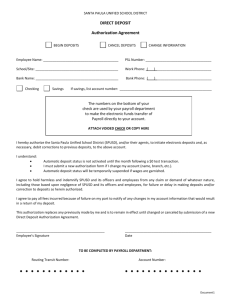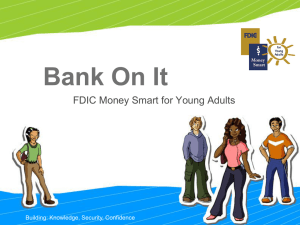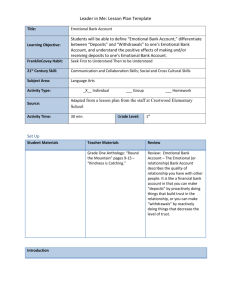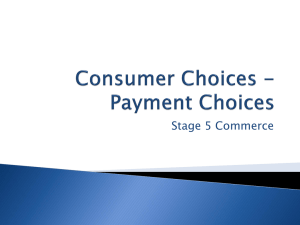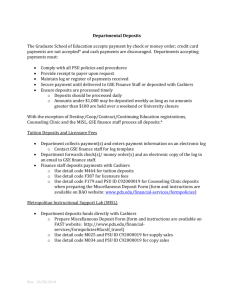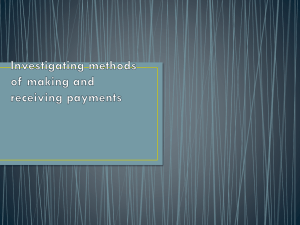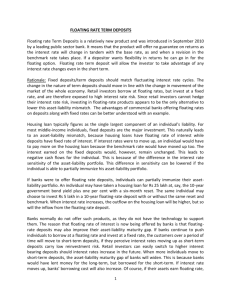File
advertisement
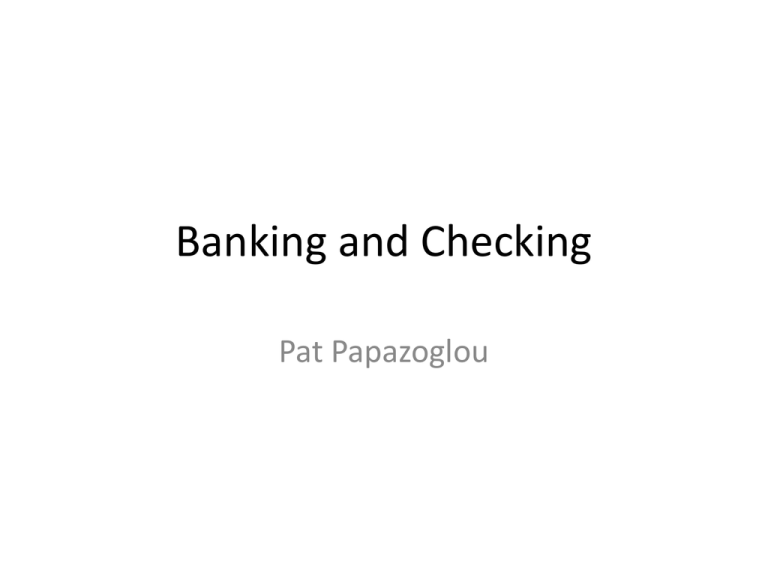
Banking and Checking Pat Papazoglou Void http://www.wikihow.com/Void-a-Check Endorse • http://www.wikihow.com/Endorse-a-Check Balance forward • Regularly recalculate the balance in the account. You can do this at each transaction, or you can do this less frequently, for example when you sit down to do bills. If you have a history of bounced check, you should do this at every transaction or every other transaction. Subtract the amount of any expense, payment, check, or withdrawal from the total. Subtract any transfer out of the account. Add the amount of any deposit, credit, or transfer into the account to the total. Signature line • http://banking.about.com/od/checkingaccoun ts/ss/Parts-Of-A-Check-What-All-TheNumbers-Mean_8.htm#step-heading Credit Credits are deposits or transfers of money into your account. Credits include cash or check deposits you make at the teller line, Automated Clearing House ("ACH") credits such as automated payroll deposits, and online banking transfers you make from another account. Check Debit • Debits are withdrawals or transfers or money out of your account. When you write a check, use your ATM or Visa® Debit (Check) card to withdraw funds or make a purchase, or make online transfers out of your account, we debit your account for the amount of the transaction. Routing number • Your bank routing number is a nine-digit code that's based on the U.S. Bank location where your account was opened. It's the first set of numbers printed on the bottom of your checks, on the left side. You can also find it in the chart below. • U.S. Bank ABA Routing Number (RTN) | SWIFT Code ... • https://www.usbank.com/checking/aba-routingnumber.html Account number • If you are looking for your account number, review your account statement or look for the set of numbers on the right of the routing number on your checks. Stub • A part of a check that is kept for record keeping purposes. For example, the stub is the part of a payroll check that includes information about the current paycheck as well as payments to date. The check stub can also be a carbon copy of a check that is made when the original check is written. • Read more: http://www.businessdictionary.com/definition/ch eck-stub.html#ixzz3KlJ5uwLO Amount line • When writing a check, you have to specify the amount using numerals (in the box on the right hand side) as well as words (on the line that says “Pay”). This practice helps to avoid confusion; if it’s difficult to read one section, you can always double check using the other section. • $10.00 • Ten dollars Register • You should use your check register as often as possible. Enter every transaction into it. When you write a check or use your debit card, put the transaction in your check register immediately. At the least, you should save ATM and debit card receipts and enter those transactions in your check register weekly. • Check number (or category) ACH Deposits, withdrawals from cash machines, dbit card use • Date • Description • Payment/Debit (-) - for payments, fees, and withdrawals • Deposit/Credit (+) - for deposits, interest, and deposits • Balance Deposit Ticket • http://www.wikihow.com/Fill-out-a-CheckingDeposit-Slip Bank • Establishment for the custody, loan, exchange, or issue of money, for the extension of credit, and for facilitating the transmission of funds. • A financial institution licensed as a receiver of deposits. There are two types of banks: commercial/retail banks and investment banks. In most countries, banks are regulated by the national government or central bank. Credit Union • a nonprofit-making money cooperative whose members can borrow from pooled deposits at low interest rates. • Member-owned financial co-operative. These institutions are created and operated by its members and profits are shared amongst the owners. • As soon as you deposit funds into a credit union account, you become a partial owner and participate in the union's profitability. Credit unions are formed by large corporations and organizations for their employees and members.


